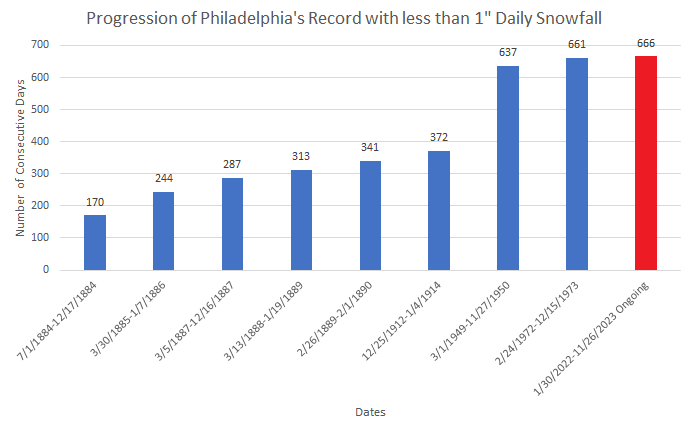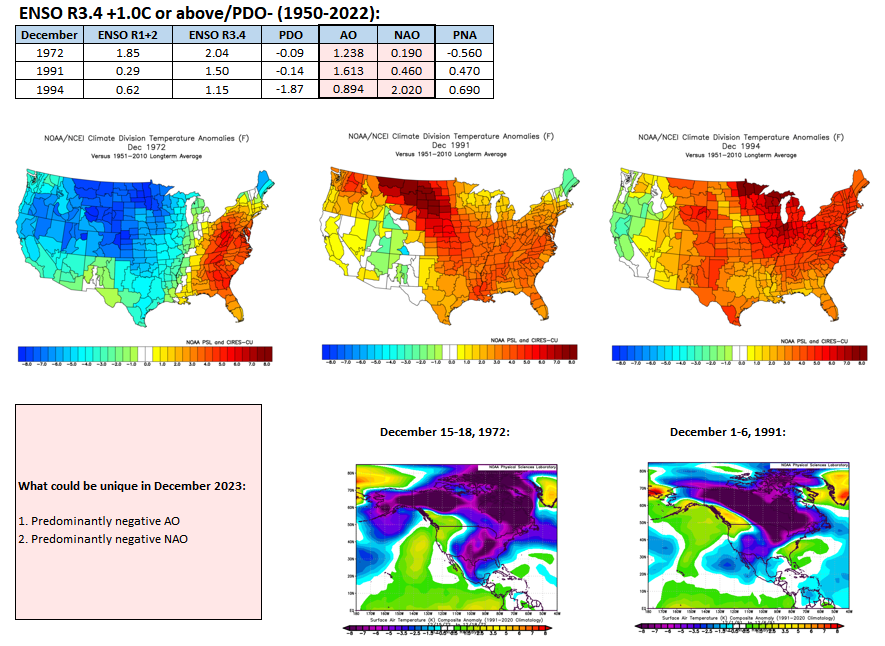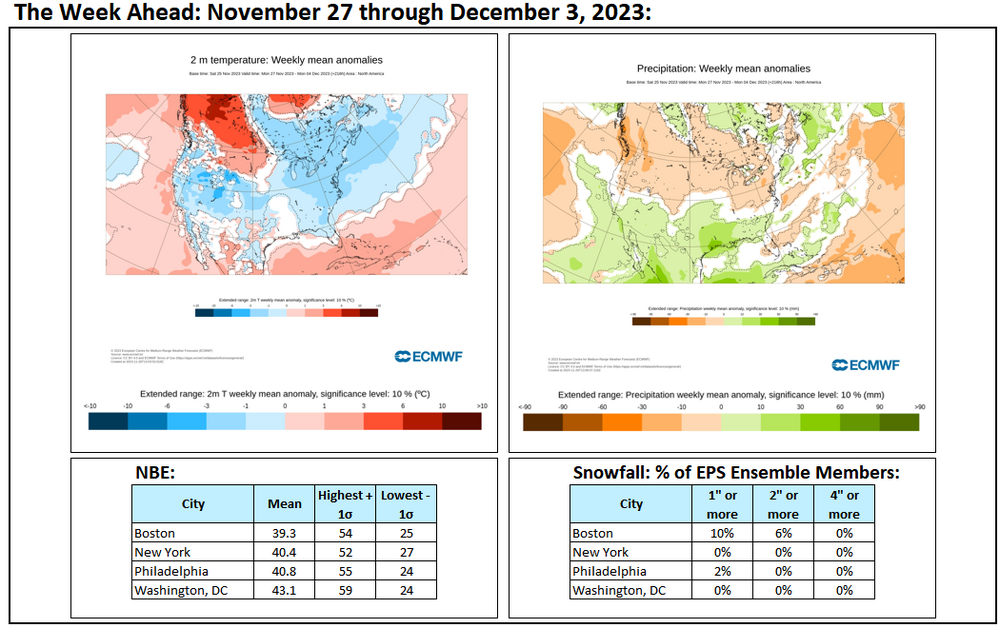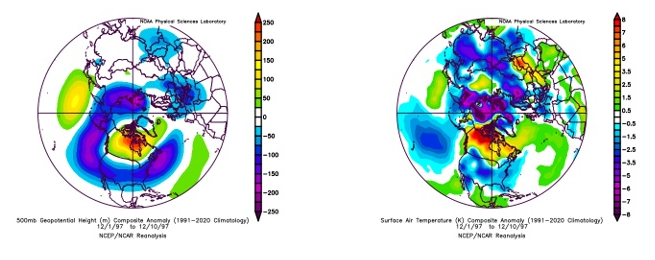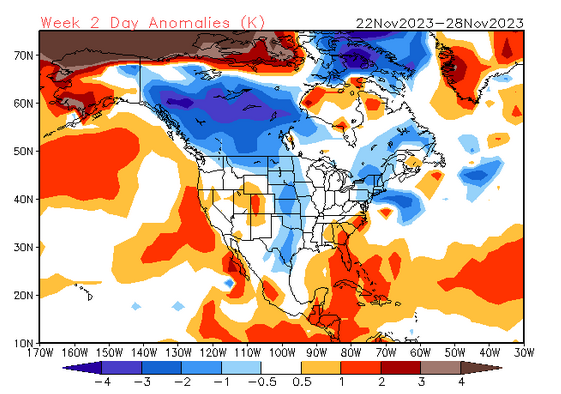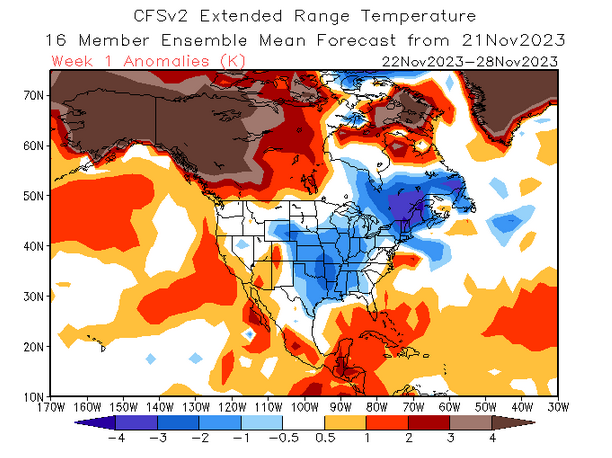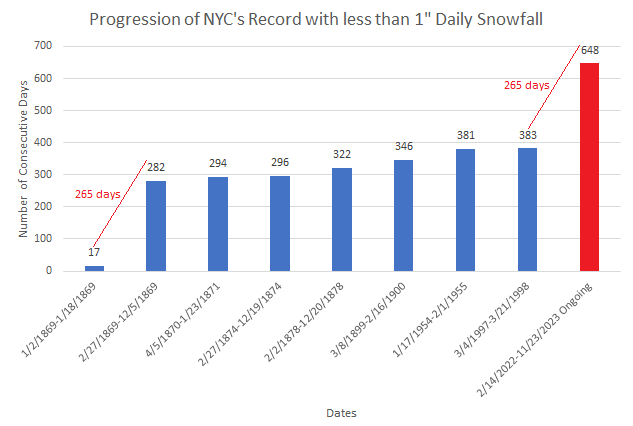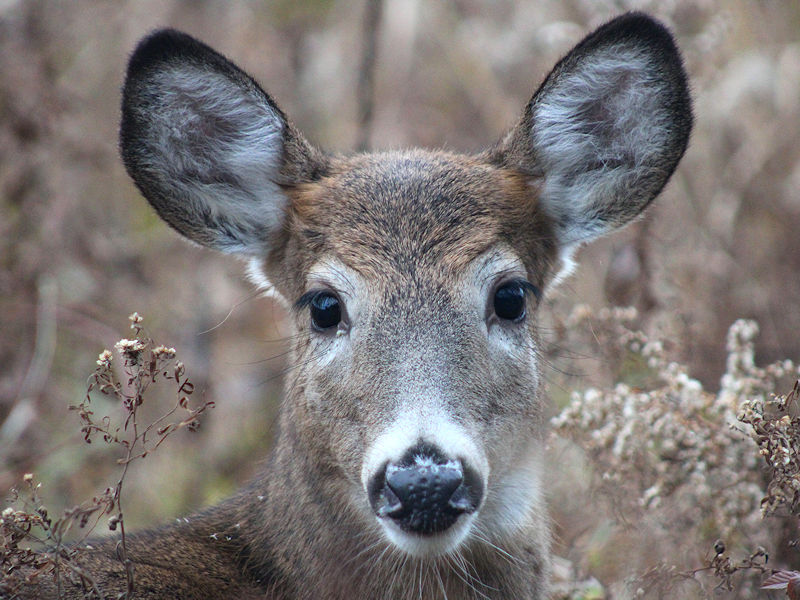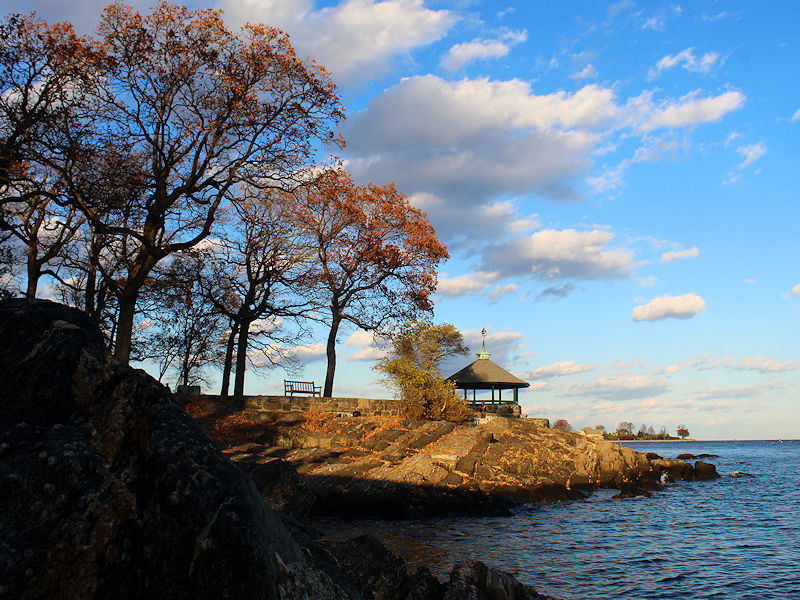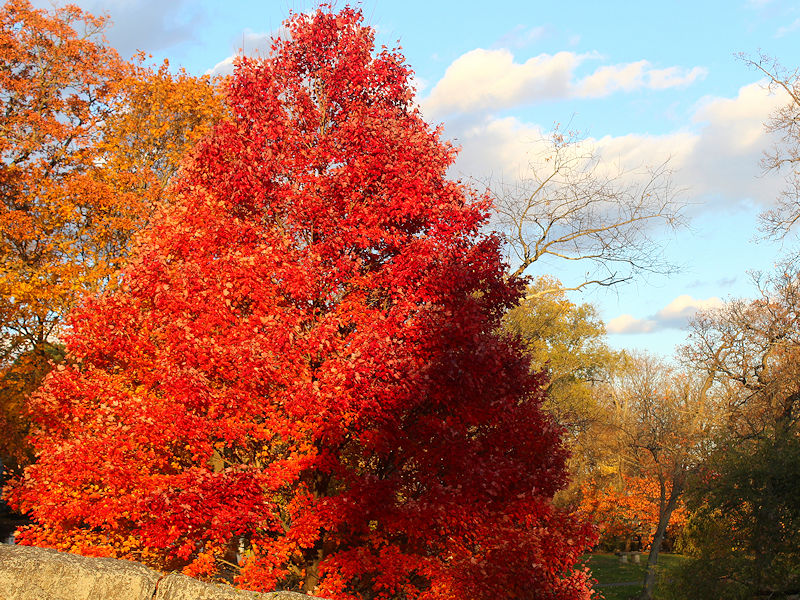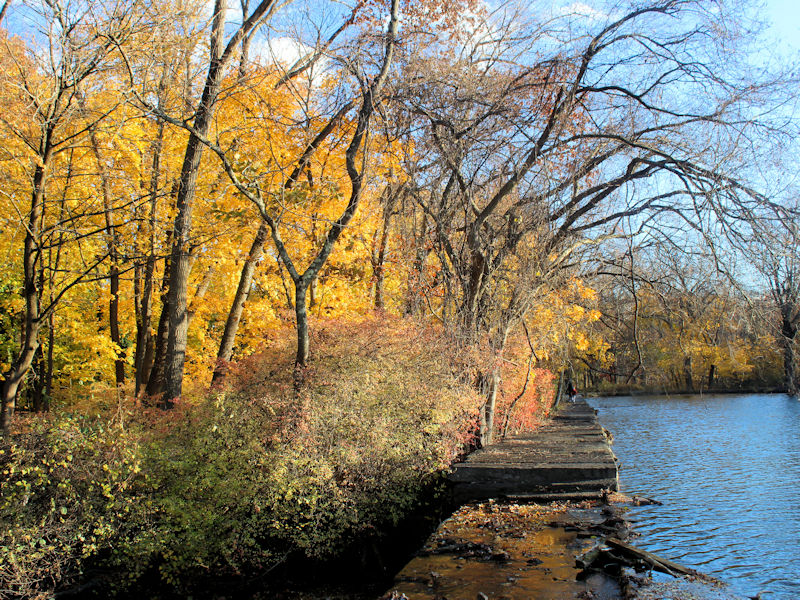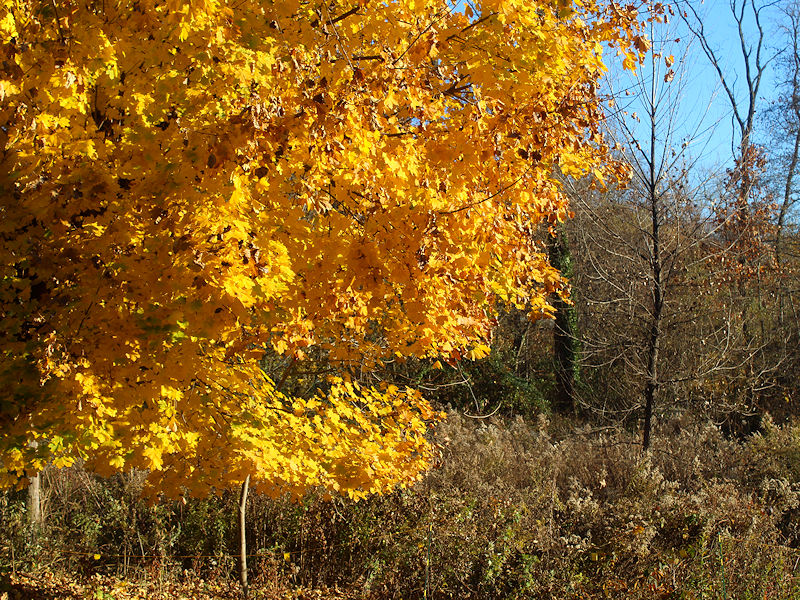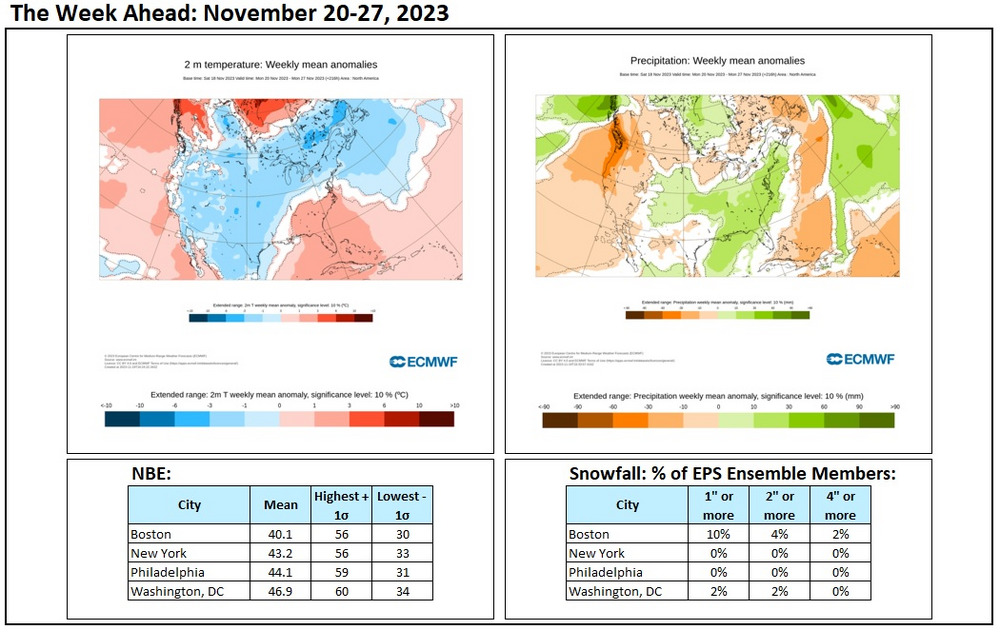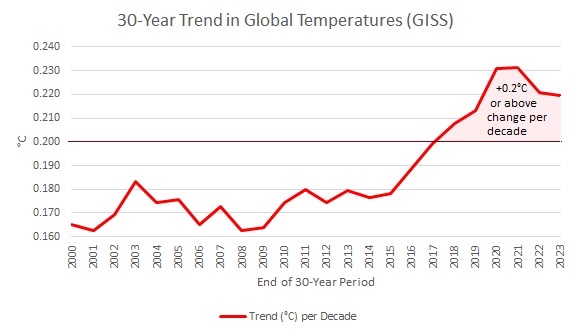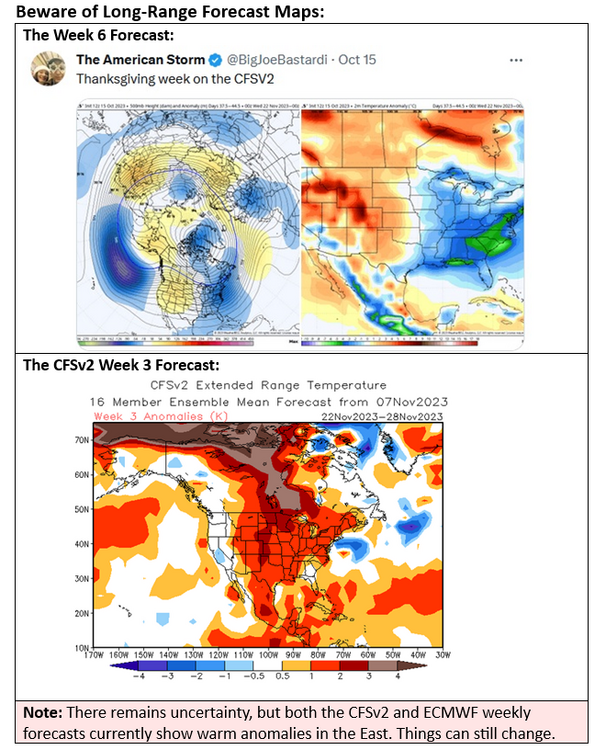-
Posts
22,981 -
Joined
Content Type
Profiles
Blogs
Forums
American Weather
Media Demo
Store
Gallery
Everything posted by donsutherland1
-

E PA/NJ/DE Fall 2023 OBS/Discussion Thread
donsutherland1 replied to Rtd208's topic in Philadelphia Region
Recently, Philadelphia set a new record for its longest streak without daily snowfall of 1" or more. Elsewhere existing records include: Allentown: 368 days Atlantic City: 715 days Baltimore: 672 days New York City: 651 days (ongoing) Richmond: 725 days Trenton: 664 days Washington, DC: 788 days Wilmington, DE: 756 days Note: All numbers are through today, as no snowfall is expected. -
December 2023 appears poised to move into little charted, if not uncharted territory for an El Niño event with a Region 3.4 anomaly of +1° or above and a negative PDO. None of the three cases since 1950 featured a predominantly negative Arctic Oscillation (AO) or North Atlantic Oscillation (NAO). The possibility of such an outcome exists this time around, possibly due to ongoing marine heatwaves that have distorted the effects of the ongoing El Niño to date. With the AAM forecast to go positive during the first week of December, there is also the risk of the development of a more typical El Niño hemispheric pattern. During that time, the MJO could approach or reach the warmer Maritime Continent phases. Some lessons from the past might be applicable, especially when one considers the periods of blocking that occurred during those past three cases (December 15-18, 1972 and December 1-6, 1991): 1. Cold could be nearby or present when Atlantic blocking is ongoing. As the climate has warmed since these cases, especially 1972, areas of cold could be less expansive and less impressive than they were during the December 1972 and December 1991 blocking episodes. Overall, December 2023 could be colder relative to normal than the 1972, 1991, and 1994 cases, but not necessarily colder than normal, as blocking should be present for a longer period of time than during those cases. 2. Monthly snowfall will likely be linked to the presence of the blocking. All of December 1991's 0.7" snowfall in New York City occurred when the AO and NAO were negative. Total snowfall for December 1972 and 1994 came to a trace. Given historic experience with the three El Niño cases above, keeping in mind the tiny sample size, there remains at least some risk that the blocking forecast for early December could break down for the second half of the month.
-
-
Clouds will increase tomorrow and it will turn milder. A system will bring rain to the region tomorrow night into Monday. Most areas should see 0.25"-0.75" of rain. The remainder of November will should be generally colder than normal with a reinforcing shot of cold air for Tuesday into Wednesday. Some flurries are possible on Tuesday or Wednesday. However, no Arctic blasts appear likely. Conditions should also be mainly dry through the remainder of the month. The ENSO Region 1+2 anomaly was +2.0°C and the Region 3.4 anomaly was +1.9°C for the week centered around November 15. For the past six weeks, the ENSO Region 1+2 anomaly has averaged +2.27°C and the ENSO Region 3.4 anomaly has averaged +1.70°C. El Niño conditions will likely continue to strengthen into the early winter as the current East-based event completes its evolution into a basinwide El Niño. Should the ENSO Region 1+2 and 3.4 anomalies remain at or above +1.00°C in December, which is likely, and should the PDO remain negative, there is a single past case (1950-2022) with similar ENSO/PDO conditions: December 1972. The SOI was not available today. The preliminary Arctic Oscillation (AO) was -0.114 today. On November 23 the MJO was in Phase 1 at an amplitude of 1.140 (RMM). The November 22-adjusted amplitude was 1.470 (RMM). Based on sensitivity analysis applied to the latest guidance, there is an implied 99% probability that New York City will have a cooler than normal November (1991-2020 normal). November will likely finish with a mean temperature near 46.0° (1.9° below normal). That would be New York City's coldest November since November 2019.
-
Ongoing marine heatwaves are distorting the atmospheric response.
-
This is possibly the unspoken fear: As long as the formative block strengthens rather than fades after the first week of December or avoids sinking southwestward to the Hudson Bay/James Bay area, there should be some opportunities even if Arctic air doesn't get involved. A breakdown in blocking would result in the development of a milder pattern, especially as the AAM is forecast to go positive starting late in the first week of December. The latter would allow the block to protrude into the Northeast, as has happened at times in recent years, which could suppress the subtropical jet stream. At this point, things are looking more promising than last winter. But beyond two weeks, model skill is low so speculative outcomes beyond mid-December are essentially guesses right now.
-
Tonight will be fair and unseasonably cold. New York City will very likely see its first freeze of the season. After a brisk but dry day tomorrow, clouds will increase on Sunday and it will turn somewhat milder. A system will bring rain to the region Sunday night into Monday. Most areas should see 0.50"-1.00" of rain. Philadelphia will likely see lesser amounts. The remainder of November will should be generally colder than normal with a reinforcing shot of cold air near the end of the month. However, no Arctic blasts appear likely. Conditions should also be mainly dry through the remainder of the month. The ENSO Region 1+2 anomaly was +2.0°C and the Region 3.4 anomaly was +1.9°C for the week centered around November 15. For the past six weeks, the ENSO Region 1+2 anomaly has averaged +2.27°C and the ENSO Region 3.4 anomaly has averaged +1.70°C. El Niño conditions will likely continue to strengthen into the early winter as the current East-based event completes its evolution into a basinwide El Niño. Should the ENSO Region 1+2 and 3.4 anomalies remain at or above +1.00°C in December, which is likely, and should the PDO remain negative, there is a single past case (1950-2022) with similar ENSO/PDO conditions: December 1972. The SOI was not available today. The preliminary Arctic Oscillation (AO) was -0.019 today. On November 22 the MJO was in Phase 1 at an amplitude of 1.570 (RMM). The November 21-adjusted amplitude was 1.470 (RMM). Based on sensitivity analysis applied to the latest guidance, there is an implied 96% probability that New York City will have a cooler than normal November (1991-2020 normal). November will likely finish with a mean temperature near 46.0° (1.9° below normal). That would be New York City's coldest November since November 2019.
-

Google + AI = Superior Weather forecasting
donsutherland1 replied to J.Mike's topic in Weather Forecasting and Discussion
Graphcast (which uses the ECMWF initialization) has had some successes beyond 500 mb verification scores so far. It did miss for tomorrow in the medium range, as it initially had a moderate to significant precipitation event for the northern Mid-Atlantic region. Unlike with the previous claims of a “superior” Panasonic model (never open for verification), Graphcast seems to be the real deal so far. -
The coldest air mass so far this season will overspread the region tomorrow. Saturday morning will likely see New York City experience its first freeze of the season. The remainder of November will likely be generally cooler than normal with a reinforcing shot of cold air near the end of the month. However, no Arctic blasts appear likely. Conditions should also be mainly dry through the remainder of the month with the only rainfall likely Sunday night or Monday morning. The ENSO Region 1+2 anomaly was +2.0°C and the Region 3.4 anomaly was +1.9°C for the week centered around November 15. For the past six weeks, the ENSO Region 1+2 anomaly has averaged +2.27°C and the ENSO Region 3.4 anomaly has averaged +1.70°C. El Niño conditions will likely continue to strengthen into the early winter as the current East-based event completes its evolution into a basinwide El Niño. Currently, 2023 is in uncharted territory as far as the ENSO Region 3.4 anomaly and PDO are concerned. The October ENSO Region 3.4 anomaly was +1.59°C while the PDO was -1.71. Prior to 2023, the lowest October PDO when the ENSO Region 3.4 anomaly was +1.00°C or above was -0.36 in 1965. Should the ENSO Region 1+2 and 3.4 anomalies remain at or above +1.00°C in December, which is likely, and should the PDO remain negative, there is a single past case (1950-2022) with similar conditions: December 1972. The SOI was -16.48 today. The preliminary Arctic Oscillation (AO) was +0.690 today. On November 21 the MJO was in Phase 1 at an amplitude of 1.570 (RMM). The November 20-adjusted amplitude was 1.578 (RMM). Based on sensitivity analysis applied to the latest guidance, there is an implied 95% probability that New York City will have a cooler than normal November (1991-2020 normal). November will likely finish with a mean temperature near 45.9° (2.0° below normal). That would be New York City's coldest November since November 2019.
-
I am glad you missed it. A few years ago, the population here was out of control. A period of bow hunting reduced the population to manageable levels.
-
The heavy rain ended early this morning. Two-day rainfall totals included: Bridgeport: 2.61" Islip: 1.62" New York City: 2.52" Newark: 2.24" Philadelphia: 1.81" Daily rainfall records were set today at: Bridgeport: 2.37" (old record: 1.52", 1991) Islip: 1.25" (old record: 0.99", 1985) New York City-LaGuardia Airport: 1.78" (old record: 1.48", 1952) Thanksgiving Day will be blustery and cooler, but not harsh. Highs should reach the upper 40s and lower 50s. An even colder air mass should arrive late in the week. Friday night or Saturday morning will likely see New York City experience its first freeze of the season. The remainder of November will likely be generally cooler than normal. However, no Arctic blasts appear likely. Conditions should also be mainly dry. The ENSO Region 1+2 anomaly was +2.0°C and the Region 3.4 anomaly was +1.9°C for the week centered around November 15. For the past six weeks, the ENSO Region 1+2 anomaly has averaged +2.27°C and the ENSO Region 3.4 anomaly has averaged +1.70°C. El Niño conditions will likely continue to strengthen into the early winter as the current East-based event completes its evolution into a basinwide El Niño. Currently, 2023 is in uncharted territory as far as the ENSO Region 3.4 anomaly and PDO are concerned. The October ENSO Region 3.4 anomaly was +1.59°C while the PDO was -1.71. Prior to 2023, the lowest October PDO when the ENSO Region 3.4 anomaly was +1.00°C or above was -0.36 in 1965. Should the ENSO Region 1+2 and 3.4 anomalies remain at or above +1.00°C in December, which is likely, and should the PDO remain negative, there is a single past case (1950-2022) with similar conditions: December 1972. The SOI was -18.07 today. The preliminary Arctic Oscillation (AO) was +1.030 today. On November 20 the MJO was in Phase 1 at an amplitude of 1.578 (RMM). The November 19-adjusted amplitude was 1.564 (RMM). Based on sensitivity analysis applied to the latest guidance, there is an implied 93% probability that New York City will have a cooler than normal November (1991-2020 normal). November will likely finish with a mean temperature near 46.0° (2.0° below normal). That would be New York City's coldest November since November 2019.
-
-
It remains to be seen how things will ultimately evolve. With the AAM forecast to go positive during or after the first week of December, a more typical El Niño pattern could try to develop.
-
The first half of December looks relatively dry. It could be tough to get to 55”.
-
A cold front will move across the region tomorrow after a storm brings a general 1.00"-2.00" rainfall with some locally higher amounts overnight. Ahead of the frontal passage, temperatures will likely soar into the middle and upper 50s. A few places will likely exceed 60°. New York City's annual precipitation, which stood at 49.18" as of 8:39 pm, will surge past 50.00". Years with 50.00" or precipitation have increased dramatically since the City's climate became abruptly wetter in 1972. The frequency of 50.00" or above years is as follows: 1869-1971: Once every 7.9 years 1972-2023*: Once every 2.3 years Since 2000*: Once every 1.8 years *Includes 2023 as a 50.00" year. 2023 currently has 49.70". No year had less than 0.30" from November 19-December 31. The record least precipitation during that timeframe was 0.67" in 1955. Following the storm and frontal passage, somewhat colder air will arrive. Thanksgiving Day will be blustery and cooler, but not harsh. Highs should reach the upper 40s and lower 50s. An even colder air mass should arrive late in the week. Friday night or Saturday morning will likely see New York City experience its first freeze of the season. The remainder of November will likely be generally cooler than normal. However, no Arctic blasts appear likely. The ENSO Region 1+2 anomaly was +2.0°C and the Region 3.4 anomaly was +1.9°C for the week centered around November 15. For the past six weeks, the ENSO Region 1+2 anomaly has averaged +2.27°C and the ENSO Region 3.4 anomaly has averaged +1.70°C. El Niño conditions will likely continue to strengthen into the early winter as the current East-based event completes its evolution into a basinwide El Niño. Currently, 2023 is in uncharted territory as far as the ENSO Region 3.4 anomaly and PDO are concerned. The October ENSO Region 3.4 anomaly was +1.59°C while the PDO was -1.71. Prior to 2023, the lowest October PDO when the ENSO Region 3.4 anomaly was +1.00°C or above was -0.36 in 1965. Should the ENSO Region 1+2 and 3.4 anomalies remain at or above +1.00°C in December, which is likely, and should the PDO remain negative, there is a single past case (1950-2022) with similar conditions: December 1972. The SOI was -18.07 today. The preliminary Arctic Oscillation (AO) was +0.535 today. On November 19 the MJO was in Phase 8 at an amplitude of 1.564 (RMM). The November 18-adjusted amplitude was 1.507 (RMM). Based on sensitivity analysis applied to the latest guidance, there is an implied 87% probability that New York City will have a cooler than normal November (1991-2020 normal). November will likely finish with a mean temperature near 46.2° (1.8° below normal). That would be New York City's coldest November since November 2019.
-
Tomorrow will be increasingly cloudy and somewhat milder. Showers could arrive late in the day or during the evening. Temperatures will generally top out in the upper 40s and lower 50s. A strong cold front will move across the region Tuesday night into Wednesday. A storm along the front will bring a general 1.00"-2.00" rainfall with some locally higher amounts. New York City's annual precipitation will surge past 50.00". Years with 50.00" or precipitation have increased dramatically since the City's climate became abruptly wetter in 1972. The frequency of 50.00" or above years is as follows: 1869-1971: Once every 7.9 years 1972-2023*: Once every 2.3 years Since 2000*: Once every 1.8 years *Includes 2023 as a 50.00" year. 2023 currently has 49.70". No year had less than 0.30" from November 19-December 31. The record least precipitation during that timeframe was 0.67" in 1955. Following the storm and frontal passage, a renewed shot of cold air will arrive. However, the latest guidance is warmer than it had been previously. Thanksgiving Day will be blustery and cooler. Some additional showers are possible Friday into Saturday. The remainder of November will likely be generally cooler than normal. However, no Arctic blasts appear likely. The ENSO Region 1+2 anomaly was +2.0°C and the Region 3.4 anomaly was +1.9°C for the week centered around November 15. For the past six weeks, the ENSO Region 1+2 anomaly has averaged +2.27°C and the ENSO Region 3.4 anomaly has averaged +1.70°C. El Niño conditions will likely continue to strengthen into the early winter as the current East-based event completes its evolution into a basinwide El Niño. Currently, 2023 is in uncharted territory as far as the ENSO Region 3.4 anomaly and PDO are concerned. The October ENSO Region 3.4 anomaly was +1.59°C while the PDO was -1.71. Prior to 2023, the lowest October PDO when the ENSO Region 3.4 anomaly was +1.00°C or above was -0.36 in 1965. Should the ENSO Region 1+2 and 3.4 anomalies remain at or above +1.00°C in December, which is likely, and should the PDO remain negative, there is a single past case (1950-2022) with similar conditions: December 1972. The SOI was not available today. The preliminary Arctic Oscillation (AO) was +1.003 today. On November 18 the MJO was in Phase 8 at an amplitude of 1.507 (RMM). The November 17-adjusted amplitude was 1.535 (RMM). Based on sensitivity analysis applied to the latest guidance, there is an implied 80% probability that New York City will have a cooler than normal November (1991-2020 normal). November will likely finish with a mean temperature near 46.4° (1.6° below normal). That would be New York City's coldest November since November 2019.
-
Tomorrow will be partly cloudy and chilly with temperatures reaching the middle and upper 40s in much of the region. The cool weather will continue through Tuesday. Afterward, a strong cold front will move across the region during the middle of the week. A storm will move along the front bringing a significant rainfall to the region. A general 1.00"-2.00" with locally higher amounts is likely. New York City's annual precipitation will surge past 50.00". Years with 50.00" or precipitation have increased dramatically since the City's climate became abruptly wetter in 1972. The frequency of 50.00" or above years is as follows: 1869-1971: Once every 7.9 years 1972-2023*: Once every 2.3 years Since 2000*: Once every 1.8 years *Includes 2023 as a 50.00" year. 2023 currently has 49.70". No year had less than 0.30" from November 19-December 31. The record least precipitation during that timeframe was 0.67" in 1955. Following the storm and frontal passage, a renewed shot of cold air will arrive. Thanksgiving Day will be blustery and cold. Another system could bring at least some precipitation to the region on Friday into Saturday. Generally cooler than normal conditions will likely persist through the remainder of November. The ENSO Region 1+2 anomaly was +2.2°C and the Region 3.4 anomaly was +1.8°C for the week centered around November 8. For the past six weeks, the ENSO Region 1+2 anomaly has averaged +2.37°C and the ENSO Region 3.4 anomaly has averaged +1.63°C. El Niño conditions will likely continue to strengthen into the early winter with the current East-based event continuing to evolve into a basinwide El Niño. Currently, 2023 is in uncharted territory as far as the ENSO Region 3.4 anomaly and PDO are concerned. The October ENSO Region 3.4 anomaly was +1.59°C while the PDO was -1.71. Prior to 2023, the lowest October PDO when the ENSO Region 3.4 anomaly was +1.00°C or above was -0.36 in 1965. Should the ENSO Region 1+2 and 3.4 anomalies remain at or above +1.00°C in December, which is likely, and should the PDO remain negative, there is a single past case (1950-2022) with similar conditions: December 1972. The SOI was +1.65 today. The preliminary Arctic Oscillation (AO) was +1.003 today. On November 17 the MJO was in Phase 8 at an amplitude of 1.535 (RMM). The November 16-adjusted amplitude was 1.563 (RMM). Based on sensitivity analysis applied to the latest guidance, there is an implied 83% probability that New York City will have a cooler than normal November (1991-2020 normal). November will likely finish with a mean temperature near 46.1° (1.9° below normal). That would be New York City's coldest November since November 2019.
-
Today was another fine fall day with bright sunshine and pleasant, if not mild temperatures. Four photos before all the leaves come down.
-
The week ahead is looking somewhat cooler than normal and wetter than normal. Snowfall for the big cities of the Northeast is unlikely. A low percentage of EPS ensemble members shows some snow for Boston.
-
Tomorrow will be fair and cooler. Monday will be chilly with temperatures reaching the middle and upper 40s in much of the region. The cool weather will continue through Tuesday. Afterward, a strong cold front will move across the region during the middle of the week. A storm will move along the front bringing a significant rainfall to the region. A general 1.00"-2.00" with locally higher amounts appears likely. New York City's annual precipitation will surge past 50.00". Years with 50.00" or precipitation have increased dramatically since the City's climate became abruptly wetter in 1972. The frequency of 50.00" or above years is as follows: 1869-1971: Once every 7.9 years 1972-2023*: Once every 2.3 years Since 2000*: Once every 1.8 years *Includes 2023 as a 50.00" year. 2023 currently has 49.70". No year had less than 0.30" from November 19-December 31. The record least precipitation during that timeframe was 0.67" in 1955. Afterward, the coldest air of the season will arrive. Thanksgiving Day could be blustery and very cold for the season with the temperature struggling into the lower 40s in New York City and perhaps Philadelphia. Temperatures will slowly moderate afterward. The ENSO Region 1+2 anomaly was +2.2°C and the Region 3.4 anomaly was +1.8°C for the week centered around November 8. For the past six weeks, the ENSO Region 1+2 anomaly has averaged +2.37°C and the ENSO Region 3.4 anomaly has averaged +1.63°C. El Niño conditions will likely continue to strengthen into the early winter with the current East-based event continuing to evolve into a basinwide El Niño. Currently, 2023 is in uncharted territory as far as the ENSO Region 3.4 anomaly and PDO are concerned. The October ENSO Region 3.4 anomaly was +1.59°C while the PDO was -1.71. Prior to 2023, the lowest October PDO when the ENSO Region 3.4 anomaly was +1.00°C or above was -0.36 in 1965. Should the ENSO Region 1+2 and 3.4 anomalies remain at or above +1.00°C in December, which is likely, and should the PDO remain negative, there is a single past case (1950-2022) with similar conditions: December 1972. The SOI was +3.05 today. The preliminary Arctic Oscillation (AO) was +1.123 today. On November 16 the MJO was in Phase 7 at an amplitude of 1.563 (RMM). The November 15-adjusted amplitude was 1.637 (RMM). Based on sensitivity analysis applied to the latest guidance, there is an implied 80% probability that New York City will have a cooler than normal November (1991-2020 normal). November will likely finish with a mean temperature near 46.1° (1.9° below normal). That would be New York City's coldest November since November 2019.
-
I agree that there’s more to the story than ENSO. It’s worth noting that since 2018, the 30-year trend has been warming at or above 0.2C per decade. It’s unclear what role this acceleration in the warming rate plays and whether it will persist. Dr. Hansen expects further acceleration. The acceleration coincides with the increase in the Earth Energy Imbalance documented by NASA.
-
Temperatures soared into the middle and upper 60s in advance of an approaching cold front. Meanwhile, Anchorage saw its November snowfall reach 39.1". That broke the November record of 38.8" from 1994 and is the 5th highest monthly figure on record. November 1994 saw an El Niño with a strongly negative PDO. The warmth will soon be a memory. A cold front will cross the region tonight bringing scattered showers. In its wake, temperatures will hold nearly steady tomorrow morning and then fall during the afternoon. Cool weather will continue through Tuesday. Afterward, a strong cold front will move across the region during the middle of the week. A moderate to significant rainfall is likely. Afterward, the coldest air of the season will arrive. Thanksgiving Day could be blustery and very cold for the season with the temperature struggling to reach the lower 40s in New York City and Philadelphia. Temperatures will slowly moderate afterward. The ENSO Region 1+2 anomaly was +2.2°C and the Region 3.4 anomaly was +1.8°C for the week centered around November 8. For the past six weeks, the ENSO Region 1+2 anomaly has averaged +2.37°C and the ENSO Region 3.4 anomaly has averaged +1.63°C. El Niño conditions will likely continue to strengthen into the early winter with the current East-based event transitioning to a basinwide El Niño. That transition continues. Currently, 2023 is in uncharted territory as far as the ENSO Region 3.4 anomaly and PDO are concerned. The October ENSO Region 3.4 anomaly was +1.59°C while the PDO was -1.71. Prior to 2023, the lowest October PDO when the ENSO Region 3.4 anomaly was +1.00°C or above was -0.36 in 1965. Should the ENSO Region 1+2 and 3.4 anomalies remain at or above +1.00°C in December, which is likely, and should the PDO remain negative, there is a single past case (1950-2022) with similar conditions: December 1972. The SOI was -0.07 today. The preliminary Arctic Oscillation (AO) was +1.539 today. On November 15 the MJO was in Phase 7 at an amplitude of 1.637 (RMM). The November 14-adjusted amplitude was 1.666 (RMM). Based on sensitivity analysis applied to the latest guidance, there is an implied 84% probability that New York City will have a cooler than normal November (1991-2020 normal). November will likely finish with a mean temperature near 46.0° (2.0° below normal). That would be New York City's coldest November since November 2019.
-
Continuing the illustration of how extended range models can fluctuate a lot over long timeframes, below is the latest CFSv2 forecast for November 22-28. Last week, it featured widespread warmth (a reversal from earlier). This week it features cool anomalies in much of Canada, parts of the Plains States, and the northeastern U.S.:


